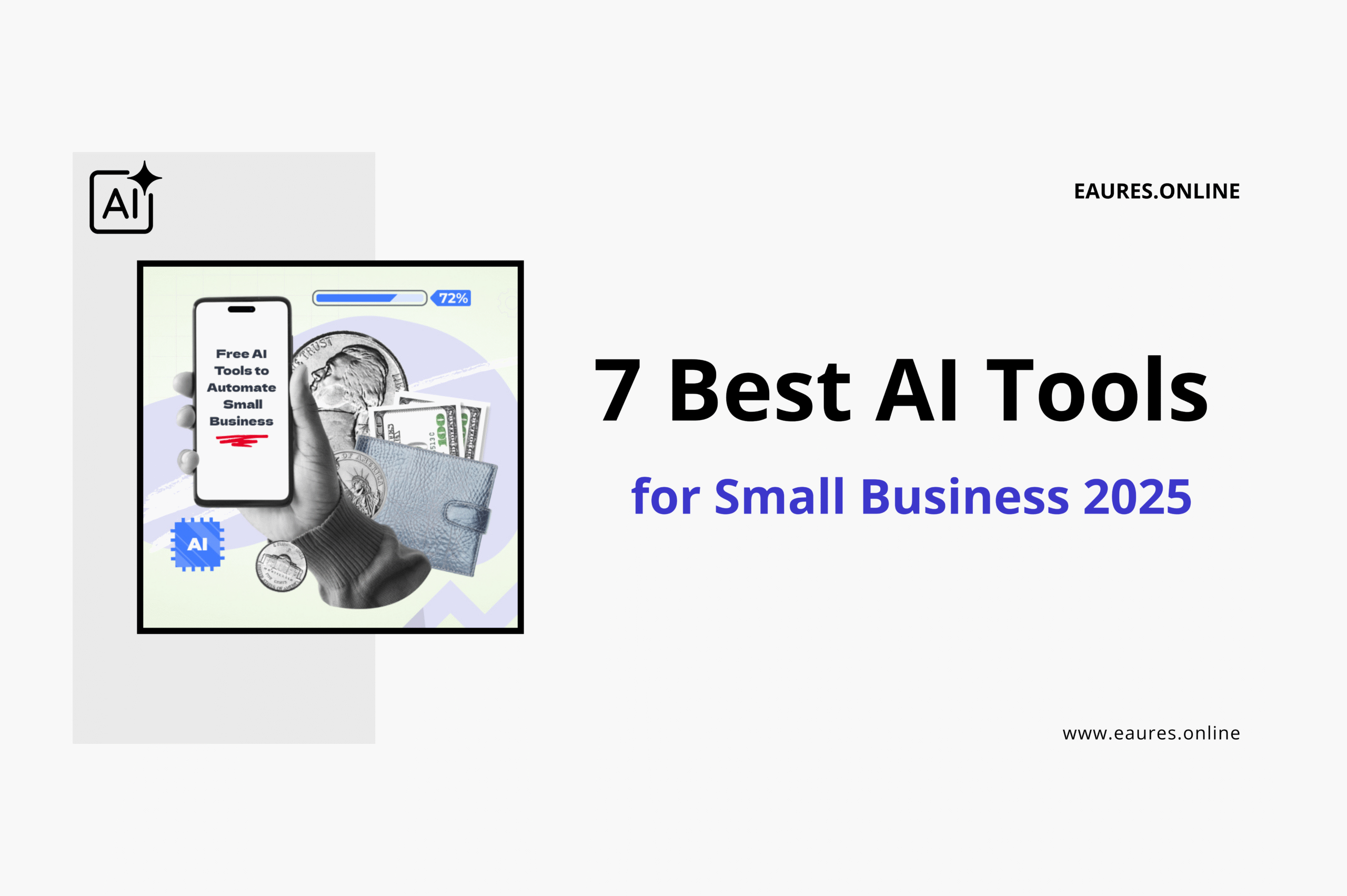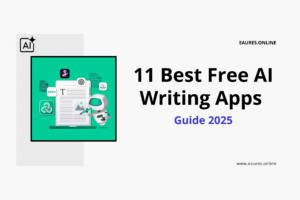Table of Contents
7 Best AI Tools for Small Business 2025
Why These Are the Best AI Tools for Small Business in 2025
The AI landscape moved from novelty to necessity in just a few cycles. Today the Best AI Tools for Small Business help owners cut busywork, scale personalized marketing, and make better decisions with fewer resources. In 2025, the right stack blends a conversational assistant, document copilots, automation, and lightweight analytics—so you get compounding value without adding headcount. If you are also mapping your broader workflow stack, this guide pairs well with an overview of the best AI tools for productivity in 2025 to ensure your planning covers both depth and breadth.
Before we dive into the top picks, it’s worth noting how quickly best practices evolve. Many owners start with a chat assistant, then layer email drafting, meeting notes, image generation, and no-code automation. Industry overviews like this Forbes roundup of 20 game‑changing AI tools for small business leaders and this practical Kipwise guide to AI tools for startups and small businesses are useful companions as you evaluate options.
How We Selected the Best AI Tools for Small Business
Choosing the Best AI Tools for Small Business hinges on more than clever demos. We score tools across six practical lenses:
- Core capability fit: Does the tool solve real small‑business jobs (lead gen, proposals, invoicing support, support replies, creative production)?
- Ease of adoption: Will a non‑technical team get value in week one without heavy training?
- Integration ecosystem: Does it connect to the apps you already use (email, CRM, calendars, storage, accounting)?
- Governance & security: Admin controls, data retention options, SSO, and clarity on model/data usage.
- ROI clarity: Time saved per task, improved conversion, or lower acquisition costs.
- Total cost of ownership: Pricing transparency, per‑seat vs. usage fees, and hidden admin overhead.
We also stress‑test common SMB scenarios—solo founders, 3–15‑person agencies, local service businesses, ecommerce boutiques—and prioritize tools that stay valuable as you grow.

Quick Summary: The 7 Best AI Tools for Small Business (and When to Use Each)
If you’re short on time, here’s the fast match between use case and tool. Each entry below is expanded later, but this TL;DR helps you pick your starting point:
- Best all‑purpose copilot: ChatGPT (Teams/Enterprise) for drafting, research, and quick analysis; it also pairs well with Claude vs ChatGPT vs Gemini vs Llama in 2025 comparisons if you’re weighing reasoning and price.
- Best for email, docs, and spreadsheets: Google Workspace with Gemini embeds suggestions directly in Gmail, Docs, and Sheets; check the official AI for small business in Google Workspace resource for use cases.
- Best for Office workflows & Teams meetings: Microsoft Copilot for Microsoft 365 excels if you live in Word, Excel, PowerPoint, and Teams.
- Best for CRM‑tied marketing & sales: HubSpot AI streamlines content, sequences, live chat, and reporting inside one hub.
- Best for automation without code: Zapier AI turns natural language into automations that connect hundreds of apps.
- Best for branding & creative production: Canva Magic Studio creates on‑brand visuals, videos, and social content in minutes.
- Best for docs, wikis, and project notes: Notion AI helps capture, summarize, and structure knowledge across teams.
Use the Best AI Tools for Small Business as modular building blocks: start with one or two, then add a workflow‑wide automation layer when your task list begins to repeat.
The 7 Best AI Tools for Small Business in 2025
1) ChatGPT (Teams/Enterprise)
Best for: All‑purpose drafting, idea generation, research assistance, data explanation, and customer interaction prototypes.
Why it stands out
The most versatile assistant for small teams remains a generalized conversational model you can point at any text heavy job. With structured prompts and a few reusable templates, ChatGPT can handle outreach drafts, summarize industry reports, outline proposals, turn transcripts into action lists, and even propose formulas for spreadsheets. If you’re comparing models by reasoning power and context length, this deep dive on Claude vs ChatGPT vs Gemini vs Llama in 2025 will help you map strengths to your daily workload.
Standout features for SMBs
- Reusable system prompts for tone and brand guidelines
- Project‑specific “memories” or instructions (in business tiers) to maintain consistency
- Rapid content transformations: rewrite, condense, translate, summarize
- Prototyping for support chat replies and brief FAQ content
Starter workflow
- Create a brand voice brief and pin it as a shared instruction.
- Build three prompt frameworks: discovery email, proposal outline, and meeting recap.
- Connect to your existing knowledge sources when possible, and keep sensitive data in approved spaces only.
Where it’s strongest
A flexible hub for the Best AI Tools for Small Business strategy—especially for teams without dedicated analysts or copywriters.
What to watch
Guardrails matter. Standardize what data can be pasted into prompts, and maintain a library of approved prompts for sales and support. For outreach, pairing with focused guidance such as these AI email prompts for sales outreach helps teams scale personalization responsibly.
2) Google Workspace with Gemini
Best for: Owners who spend their day in Gmail, Docs, and Sheets.
Why it stands out
You get AI exactly where you already write and analyze. In Gmail, generate and polish replies. In Docs, draft content and proposals. In Sheets, ask questions in natural language to explore data or build formulas. For a vendor‑maintained overview of small‑business scenarios, see Google’s official guidance on AI for small business with Workspace.
Standout features for SMBs
- Drafting and rewriting inline in Gmail and Docs
- Formula suggestions, data classification, and cleanup in Sheets
- Smart summaries for meeting notes stored in Drive
- Enterprise‑friendly admin controls and data handling
Starter workflow
- Turn on Gemini features for a pilot group (sales + ops).
- Standardize Gmail response templates (prospecting, support triage).
- Use Sheets to create a live “operating metrics” workbook; use AI to describe trends in plain English.
Where it’s strongest
Natural extension of existing habits; this is often the fastest route to value among the Best AI Tools for Small Business if your team already lives in Workspace.
What to watch
Train your team on consent and context—don’t generate sensitive email content without double‑checking recipients and attachments. For more examples, community articles like the Thryv list of free AI tools can inspire simple uses before you expand.

3) Microsoft Copilot for Microsoft 365
Best for: Teams standardized on Outlook, Word, Excel, PowerPoint, and Teams.
Why it stands out
Copilot meets you inside the apps you already know. It summarizes meetings in Teams, drafts slide decks from briefs, and explores spreadsheets in natural language. For many business owners, that “no new app” advantage is worth a lot—on‑ramp time is minimal and value shows up in the first week.
Standout features for SMBs
- Meeting recaps with action items directly in Teams
- Slide generation and speaker notes in PowerPoint
- Natural language queries over Excel tables for quick analysis
- Policy and security control via Microsoft 365 admin center
Starter workflow
- Run a weekly “Copilot office hour” to collect prompts that work in Word and Excel.
- Use a standard prompt to convert Teams meeting transcripts into structured task lists and share them automatically.
- Build a “proposal deck” template and have Copilot generate first drafts from a simple intake form.
Where it’s strongest
Office‑centric organizations that want the Best AI Tools for Small Business without asking staff to switch ecosystems.
What to watch
For spreadsheet analysis, clean your data first. Garbage in, garbage out applies as much to AI as to formulas. Also, outline which meeting types are recorded and summarized to avoid surprises.
4) HubSpot AI (Marketing, Sales, and Service)
Best for: Lead generation, email sequences, live chat, and reporting within a single CRM.
Why it stands out
HubSpot’s AI features tie content creation to contacts, deals, and support tickets. That means your drafts, chat flows, and follow‑ups aren’t isolated—they’re associated with outcomes. If your top bottleneck is “not enough qualified conversations,” pairing a CRM with AI helps you move from copy to conversion in one place.
Standout features for SMBs
- AI‑assisted blog briefs, landing pages, and ad variations
- Sales email and sequence suggestions mapped to pipeline stages
- Chatbot flows that escalate to humans with context
- Auto‑summaries of contact interactions and ticket history
Starter workflow
- Build three persona‑based landing pages and have AI propose copy variants.
- Generate a sales sequence (3–5 steps) and let reps personalize the first lines.
- Use AI summaries to prep for calls—focus the live conversation on gaps.
Where it’s strongest
Owner‑operators and small sales teams looking to operationalize marketing without adding more tools to the mix. Articles like the Kipwise SMB guide to AI tools can also inform your broader stack beyond CRM.
What to watch
Keep deliverability healthy—don’t let AI tempt you into sending more than your domain reputation can support. If you’re scaling outreach, lean on proven frameworks like the AI email prompts for sales outreach to maintain quality.
5) Zapier AI
Best for: Turning repetitive tasks into no‑code automations triggered by plain language.
Why it stands out
Every small business has glue work—copying leads from forms to CRMs, saving attachments, updating spreadsheets, sending notifications. Zapier’s AI turns “tell me what you want to happen” into workflows that connect hundreds of apps. It’s often the highest‑leverage addition to a stack because it compounds: every new tool you add can be wired into everything else.
Standout features for SMBs
- Natural‑language builder for automations (“When a new lead arrives, score it and send to Slack”)
- AI assistants that classify, summarize, or rewrite text mid‑flow
- Shared libraries of “Zaps” to templatize across teams
- Robust logging and error handling so you can trust it in production
Starter workflow
- Map your top five repetitive tasks; measure minutes saved per task.
- Build a single source of truth spreadsheet and keep it updated via Zaps from forms, calendars, and email.
- Insert AI steps to score leads or clean data (e.g., standardize phone formats).
Where it’s strongest
When you’ve chosen two or three of the Best AI Tools for Small Business and want them to talk to each other without code.
What to watch
Automations need maintenance. Document each workflow, owners, and dependencies. Schedule a monthly review to prune unused Zaps and examine error logs.
6) Canva Magic Studio
Best for: Fast, on‑brand creative for social, ads, flyers, pitch decks, and light video.
Why it stands out
Small teams need good visuals, but hiring design help for every asset is unrealistic. Canva’s Magic Studio brings AI to ideation, layout, resizing, background removal, and video snippets—so non‑designers can ship assets that look professional. It’s a favorite of local services, creators, and boutique ecommerce brands.
Standout features for SMBs
- Brand kits that enforce fonts, colors, and logos
- Magic Write, Magic Design, and Magic Expand for quick variations
- One‑click resize for platform‑specific formats
- Simple video trimming and captioning
Starter workflow
- Build a brand kit and lock it for the whole workspace.
- Draft a social calendar; use Magic Design to generate first‑pass assets.
- Export to your scheduler, then iterate weekly based on engagement.
Where it’s strongest
Visual storytelling for teams that don’t have full‑time design resources but still want the Best AI Tools for Small Business impact on brand perception.
What to watch
Create a simple approval step for anything public‑facing. AI can accelerate production, but human eye keeps quality tight.

7) Notion AI
Best for: Knowledge capture, meeting notes, SOPs, project briefs, and light research.
Why it stands out
Notion turns free‑form notes into structured docs and databases. With AI layered in, you can summarize long pages, extract action items, generate PRDs from bullet points, and keep a living wiki updated easily. For teams drowning in documents, this is a relief valve that also improves onboarding.
Standout features for SMBs
- AI summaries and action‑item extraction on any page
- Page‑to‑database conversion and custom properties
- Templates for SOPs, roadmaps, and content briefs
- Cross‑linking across projects for context‑rich navigation
Starter workflow
- Choose one source of truth for meeting notes and decisions.
- Create a “Daily Brief” template that auto‑summarizes yesterday’s updates.
- Build a lightweight project tracker; use AI to generate weekly status summaries.
Where it’s strongest
Organizing the brain of the company. Among the Best AI Tools for Small Business, Notion AI helps keep knowledge usable as you scale.
What to watch
Agree on naming conventions and ownership. Without structure, even great notes become noise. A consistent hierarchy pays off.
Implementation Playbook: Turning the Best AI Tools for Small Business into Results
Step 1: Align on your first three outcomes (Week 1)
Pick three measurable wins that Best AI Tools for Small Business can influence immediately:
- Reduce average email response time from 24h to 6h
- Produce four on‑brand social assets per week
- Automate lead capture and enrichment into CRM
Document owners, baseline metrics, and a simple “definition of done.”
Step 2: Pilot with a small, cross‑functional group (Weeks 2–3)
Choose 3–5 people (owner, sales, ops, marketing). Give them templates, sample prompts, and access to two tools from this list. In parallel, watch a concise small business AI walkthrough video together and list three “this would help us” ideas. Capture feedback in a shared doc.
Step 3: Standardize prompts and workflows (Weeks 4–6)
Prompts are processes. Convert the ad‑hoc chat experiments into named templates:
- “Inbound lead first reply” (ChatGPT or HubSpot)
- “Sales recap + next steps” (Notion AI)
- “New order → Slack alert → shipping label” (Zapier AI)
- “Weekly metrics brief from spreadsheet” (Google or Microsoft)
House these in a central wiki and require team usage before improvising.
Step 4: Secure and govern (Week 6+)
Define a simple policy: what data is allowed in prompts, where to store generated content, and who approves public‑facing outputs. For small teams, a one‑page policy beats silence. To broaden your view, the Forbes list of AI tools for SMB leaders includes governance talking points you can adapt.
ROI Math: Estimating Payback from the Best AI Tools for Small Business
A pragmatic ROI model keeps adoption honest. Here’s a straightforward way to estimate value:
- Time saved per task × frequency × fully loaded hourly rate = monthly time value
- Conversion lift from better copy or faster follow‑ups × average order value = revenue delta
- Cost to operate = seats + usage + 10–15% admin overhead
Example
- Drafting emails: 8 minutes saved × 40/week × $35/hr ≈ $187/month/team member
- Social assets: 60 minutes saved × 4/week × $35/hr ≈ $560/month
- Automation: 5 minutes saved × 150 tasks/week × $35/hr ≈ $1,750/month
- Added conversion (conservative): +2 deals/month × $600 ≈ $1,200/month
If your stack costs $300–$600/month across a few seats, you can see positive ROI within the first quarter. Articles like the Thryv round‑up of free AI tools are helpful to test concepts before committing to paid tiers.
Pro Tips to Get More from the Best AI Tools for Small Business
Treat prompts like SOPs
Write them, name them, version them. Store them in your wiki. Share only the latest version. When you change your brand voice, update the prompt file and notify the team. This alone improves output consistency across the Best AI Tools for Small Business.
Build a small “golden dataset”
Keep a private folder of your best emails, proposals, and reports. Use those as few‑shot examples in assistants like ChatGPT and Gemini. The model learns style from examples more reliably than from adjectives.
Connect tools with lightweight automation
Once you’ve chosen your two or three favorites from the Best AI Tools for Small Business, plug them together with Zapier AI. Start with notifications and data hygiene; then graduate to scoring, routing, and fulfillment triggers.
Educate with internal linkable resources
If you plan to scale AI assistants across the company, reading a focused comparison of modern copilots—like this breakdown of AI assistants for small business in 2025—helps your team make consistent choices and avoid tool sprawl.
Common Questions About the Best AI Tools for Small Business
Are these tools beginner‑friendly?
Yes. The Best AI Tools for Small Business emphasize natural language. Most value shows up from guided prompts and templates, not advanced setups.
Do I need all seven?
No. Begin with an all‑purpose assistant (ChatGPT), then add a document copilot (Google or Microsoft), and one automation layer (Zapier AI). As needs grow, add HubSpot AI for sales/marketing, Canva for creative, and Notion AI for knowledge.
How do I keep my data safe?
Use business tiers where available, enable SSO, and restrict sensitive data in prompts. Store outputs in approved locations and avoid pasting full customer lists or credentials into any assistant.
What about free options?
Free tiers are useful for proof‑of‑concepts. When you find a workflow that saves hours weekly, upgrade to business plans for admin control, reliability, and compliance. Lists like the Thryv overview of free AI tools can help you explore safely.
Where can my team learn quickly?
Combine vendor help centers with curated explainers. Google’s Workspace AI for small business is a solid starting point, and community guides such as the Kipwise SMB AI tools overview keep examples practical.

The Final Verdict: Build a Lean, Connected Stack
The Best AI Tools for Small Business in 2025 share a pattern: they live where you already work, respect your time, and connect to the rest of your stack. Start with a general assistant like ChatGPT to accelerate writing and analysis. Add Google Workspace with Gemini or Microsoft Copilot for day‑to‑day documents and meetings. Wire your apps together with Zapier AI to remove repetitive work. Bring brand and content production to life with Canva Magic Studio. Keep your team aligned in Notion AI, and grow your pipeline with HubSpot AI.
Stacked thoughtfully, these seven tools compound into a quiet advantage: your team spends more time with customers and less time pushing pixels, copying data, or reinventing the same email.
For additional reading as you fine‑tune your stack, a broad industry perspective like the Forbes guide to AI tools for small‑business leaders helps you zoom out, while hands‑on videos such as this small business AI walkthrough help you zoom in.
Tool‑by‑Tool Mini‑Checklist
Use this quick reference as you pilot the Best AI Tools for Small Business:
ChatGPT (Teams/Enterprise)
- Brand voice prompt
- Email/brief/proposal templates
- Red‑team checklist before publishing
Google Workspace with Gemini
- Gmail reply styles
- Docs proposal outline template
- Sheets “metrics brief” prompt
Microsoft Copilot for Microsoft 365
- Teams summary format
- PowerPoint deck skeleton
- Excel data dictionary
HubSpot AI
- Three persona pages + copy variants
- 5‑step sales sequence
- Support macro library
Zapier AI
- Lead capture → CRM → Slack alert
- Attachment save rules
- Monthly Zap review
Canva Magic Studio
- Brand kit locked
- Social calendar design presets
- Video caption template
Notion AI
- Meeting note template
- Weekly status summary
- SOP library with AI assistance
Related Resources (Contextual)
If you want to go deeper on assistant selection and prompts that scale, these resources fit neatly into the Best AI Tools for Small Business journey: model comparisons in Claude vs ChatGPT vs Gemini vs Llama in 2025, and proven AI email prompts for sales outreach to jumpstart replies.




